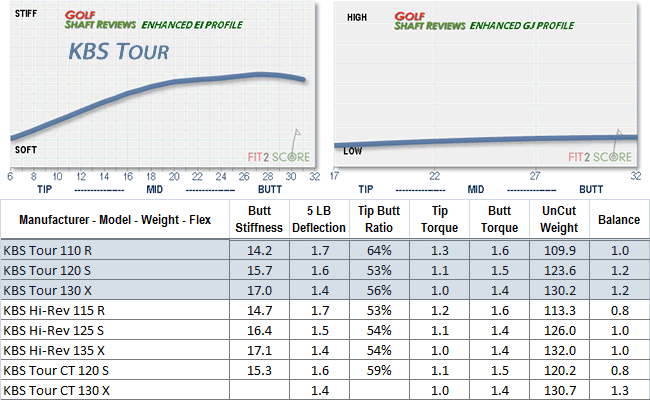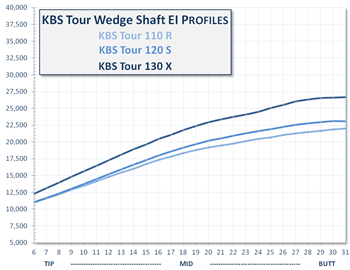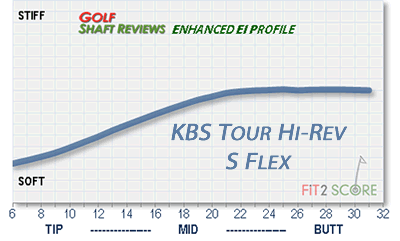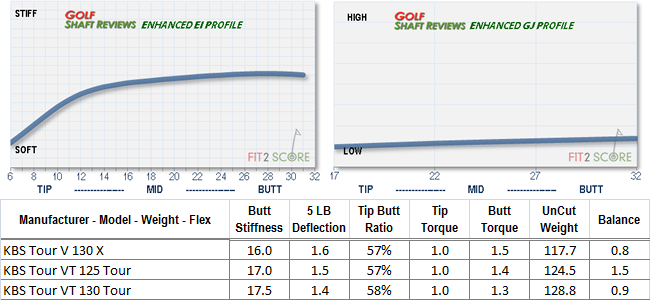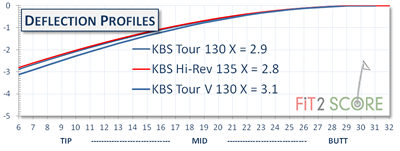Nippon N.S.Pro Super Peening
By Russ Ryden, A Golf Digest America’s 100 Best Clubfitter
Translation by Jacobo Canal Vila
Me encuentro en proceso de reconstrucción de la base de datos de Fit2Score con los perfiles del hierro 3 y del wedge. Nippon ha enviado una caja de muestras para revisar, incluyendo la the N.S.Pro Super Peening Orange and Blue. Yo había observado brevemente en el pasado las varillas para wedge Super Peening Blue. Habían sido sugeridas como añadido a los wedges de mi sistema de fitting. Los lectores habían preguntado en numerosas ocasiones acerca de estas varillas por lo que me interesé en conseguir un amplio número de medidas de estas muestras.
Las varillas N.S.Pro Super Peening no aparecen ya en los folletos de Nippon. He tenido que hacerme con un catálogo de 2008 para ver cómo Nippon presentaba las varillas. Las descripciones eran breves, y los términos usados para describir las varillas Orange = Punto de Flexión Medio and Blue = Punto de Flexión Alto me trajo de vuelta a ese tiempo en el que aprendía a pensar en las varillas en esos términos. Nos enseñaban que a más alto kick point , menor lanzamiento. La búsqueda de perfiles EI expandió enormemente el entendimiento sobre una varilla de golf, más allá de cosas como la coincidencia de kick point y emparejamiento de frecuencia. Al observar las medidas de estas dos varillas me di cuenta de que son dos buenos ejemplos para discutir la naturaleza de los 3 puntos en los perfiles EI.
El “punto de flexión medio” de la Orange tiene una curva EI más pronunciada que la “punto de flexión alto” de la Blue. Así, simplemente mirando a la curva EI, uno puede ver la propensión al lanzamiento de la varilla. Además, el ratio “punta – parte alta” indica lanzamiento. La Blue, con un diseño de lanzamiento más bajo tiene un número más alto, la rigidez de la punta tiene un porcentaje mayor que la del extremo. Eso significa que hay menos cambio entre la rigidez de la punta y el extremo de la varilla. Cuanto menor sea el cambio, menor será la propensión de la varilla al lanzamiento.
Como se ve en la gráfica 1, hay una mayor pérdida de rigidez en el “mid kick”, mayor lanzamiento en la Orange que le “high kick”, menor lanzamiento en la Blue.
Las curvas EI son una visión refinada de la propensión al lanzamiento. Volvamos a mirar la firma de rigidez. Las varillas de los hierros 3 pierden más rigidez cerca de la cabeza que las varillas de los wedges del set. Un fitter que conozca los perfiles de las varillas puede trabajar más rápidamente y tomar decisiones basadas en sus conocimientos de las mismas. Tendrá un conocimiento fundamental de las varillas que te mostrará durante el fitting. Tal y como lees, aquí, en el futuro, en las revisiones de las varillas de los hierros, discutiremos sobre los perfiles del set.
La mayoría de los puntos de flexión están alterados en cierta medida a lo largo del set. Unos hierros más cortos no son simplemente más rígidos. Están diseñados, ya sea intencionadamente o como subproducto del material o estructura, para tener puntos de flexión más altos. Como consecuencia, la propensión al lanzamiento de la bola es menor.
Como he pasado de una simple visión de la sección de la varilla con el software Fit2score comparando el hierro 6 a una visión expandida del set, me pregunto a mí mismo por qué los sets de hierros no han sido siempre presentados de esta manera a la comunidad fabricante de palos de golf. Fue a través de mi participación en PCS que me encontré por primera vez el concepto de la realización de perfiles de varillas utilizando instrumentos de frecuencia. Como me hice a mí mismo la pregunta, ¿por qué hierros 6 y no sets?, yo mismo la respondí. El sistema de frecuencia con un peso de 454 g en la punta no puede medir la rigidez de la misma habitualmente vista en la zona de hierros cortos del set. Esto fue rápidamente confirmado por uno de nuestros editores, John Dranschak, en el día de hoy. Como la instrumentación y la tecnología evolucionan, los sistemas que utilizan para comprender la maquinaria del golf hacen lo mismo. Entender las varillas de los hierros mirando solamente al perfil de la varilla de un hierro 6 es mejor que no saber nada sobre los perfiles de flexión de las varillas. Pero la visión expandida, mirando también los hierros largos y cortos de la bolsa es una herramienta esencial en el fitting de un set de hierros.
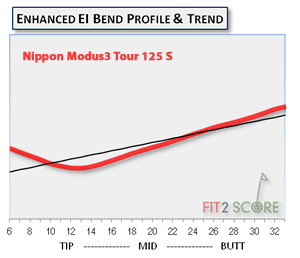
He medido estas varillas y las he comparado con la línea de producto Modus 3. He publicado una revisión del nuevo Modus 3 Tour 125. Rápidamente me he dado cuenta de que el Modus 3 Tour 125 es muy parecido al Super Peening Blue; es difícil distinguirlos. Mientras que ambos están asignados a varillas de 125 g, la nueva metalurgia usada en las varillas Modus3, da como resultado en la misma varilla alrededor de 5 g más ligera. Todo lo demás es prácticamente idéntico. Si jugaste la Super Peening Blue en el pasado, estarás acostumbrado a la sensación y el rendimiento de la nueva Modus 3 Tour 125.




